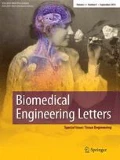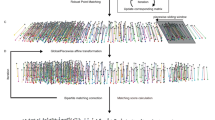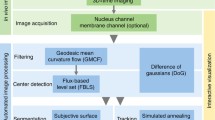Abstract
In recent years, development of image processing methods has rapidly progressed to automatically identify spatiotemporal dynamics of embryonic cells in Caenorhabditis elegans. The methods allow quantitative and high-throughput analysis for molecular dynamics during embryogenesis. In turn, the analyzed dynamics can be merged onto a reference embryo, providing an integrated view of embryogenesis. This integration is enabled by invariant embryogenesis of C. elegans, which is the most unique advantage offered by this organism. Therefore, the key point in the development of the methods is how to take advantage of this feature. In this article, we review a series of development of such methods and their applications. First, we describe basic image processing methods that are the basis for development of cell identification methods. Next, we describe methods that have succeeded to identify cells in images and their performance. Finally, we review studies that have employed cell identification methods to analyze the variability of cellular dynamics, cellcell contacts and cell fate determination. Together with advances in imaging technologies to measure molecular dynamics and computational methods to identify such dynamics with high accuracy, the unique system of invariant embryogenesis in C. elegans will be invaluable to study developmental mechanisms. Therefore, it is important to understand the ever developing technologies and their results.
Similar content being viewed by others
References
Ankeny R. The natural history of Caenorhabditis elegans research. Nat Rev Genet. 2001; 2(6):474–9.
Sulston J, Schierenberg E, White J, Thomson J. The embryonic cell lineage of the nematode Caenorhabditis elegans. Dev Biol. 1983; 100(1):64–119.
Riddle DL, Blumenthal T, Meyer BJ, Priess JR. C. elegans II. 2nd ed. NY USA: Cold Spring Harbor Laboratory Press; 19–7.
Onami S, Hamahashi S, Nagasaki M, Miyano S KH. Automatic acquisition of cell lineage through 4D microscopy and analysis of early C. elegans embryogenesis. In: Kitano H. Foundations of Systems Biology. London: The MIT Press; 2001. pp. 39–55.
Hamahashi S, Onami S, Kitano H. Detection of nuclei in 4D Nomarski DIC microscope images of early Caenorhabditis elegans embryos using local image entropy and object tracking. BMC Bioinformatics. 2005; 6–125.
Bao Z, Murray JI, Boyle T, Ooi SL, Sandel MJ, Waterston RH. Automated cell lineage tracing in Caenorhabditis elegans. Proc Natl Acad Sci USA 2006; 103(8):2707–12.
Azuma Y, Onami S. Evaluation of the effectiveness of simple nuclei-segmentation methods on Caenorhabditis elegans embryogenesis images. BMC Bioinformatics. 2013; 14–295.
Long F, Peng H, Myers E. Automatic segmentation of nuclei in 3D microscopy images of C. Elegans. Conf Proc IEEE Int Symp Biomed Imaging Nano Macro. 2007; 1:536–9.
Santella A, Du Z, Nowotschin S, Hadjantonakis A-K, Bao Z. A hybrid blob-slice model for accurate and efficient detection of fluorescence labeled nuclei in 3D. BMC Bioinformatics. 2010; 11–580.
Luengo-Oroz MA, Ledesma-Carbayo MJ, Peyriéras N, Santos A. Image analysis for understanding embryo development: a bridge from microscopy to biological insights. Curr Opin Genet Dev. 2011; 21(5):630–7.
Uchida S. Image processing and recognition for biological images. Dev Growth Differ. 2013; 55(4):523–49.
Giurumescu CA, Kang S, Planchon TA, Betzig E, Bloomekatz J, Yelon D, Cosman P, Chisholm AD. Quantitative semiautomated analysis of morphogenesis with single-cell resolution in complex embryos. Development. 2012; 139(22):4271–9.
Malpica N, de Solórzano CO, Vaquero JJ, Santos A, Vallcorba I, García-Sagredo JM, del Pozo F. Applying watershed algorithms to the segmentation of clustered nuclei. Cytometry. 1997; 28(4):289–97.
Vincent L, Soille P. Watersheds in digital spaces: an efficient algorithm based on immersion simulations. IEEE Trans Pattern Anal Mach Intell. 1991; 13(6):583–98.
Roerdink JBTM, Meijster A. The watershed transform: definitions, algorithms and parallelization strategies. Fundamenta Informaticae. 2000; 41(1):187–228.
Crandall R. Image segmentation using the Chan-Vese algorithm. 2009. http://math.arizona.edu/~rcrandall/ECE532_ProjectPaper.pdf. Accessed 07 Jan 2015.
Xiong Y, Iglesias PA. Tools for analyzing cell shape changes during chemotaxis. Integr Biol. (Camb). 2010; 2(11–12):561–7.
Chen S, Zhao M, Wu G, Yao C, Zhang J. Recent advances in morphological cell image analysis. Comput Math Methods Med. 2012; doi: 10.1155/2012/101536.
Chan TF, Vese LA. Active Contours Without Edges. IEEE Trans Image Proc. 2001; 10(2):266–77.
Meijering E, Dzyubachyk O, Smal I, van Cappellen WA. Tracking in cell and developmental biology. Semin Cell Dev Biol. 2009; 20(8):894–902.
Lin G, Adiga U, Olson K, Guzowski JF, Barnes CA, Roysam B. A hybrid 3D watershed algorithm incorporating gradient cues and object models for automatic segmentation of nuclei in confocal image stacks. Cytometry A. 2003; 56(1):23–36.
Keller PJ, Schmidt AD, Santella A, Khairy K, Bao Z, Wittbrodt J, Stelzer EHK. Fast, high-contrast imaging of animal development with scanned light sheet-based structured-illumination microscopy. Nat Methods. 2010; 7:637–42.
Chinta R, Wasser M. Three-dimensional segmentation of nuclei and mitotic chromosomes for the study of cell divisions in live Drosophila embryos. Cytometry A. 2012; 81(1):52–64.
Long F, Peng H, Liu X, Kim SK, Myers E. A 3D digital atlas of C. elegans and its application to single-cell analyses. Nat Methods. 2009; 6(9):667–72.
Aerni SJ, Liu X, Do CB, Gross SS, Nguyen A, Guo SD, Long F, Peng H, Kim SS, Batzoglou S. Automated cellular annotation for high-resolution images of adult Caenorhabditis elegans. Bioinformatics. 2013; doi: 10.1093/bioinformatics/btt223.
Bao Z, Zhao Z, Boyle TJ, Murray JI, Waterston RH. Control of cell cycle timing during C. elegans embryogenesis. Dev Biol. 2008; 318(1):65–72.
Hench J, Henriksson J, Lüppert M, Bürglin TR. Spatio-temporal reference model of Caenorhabditis elegans embryogenesis with cell contact maps. Dev Biol. 2009; 333(1):1–13.
Richards JL, Zacharias AL, Walton T, Burdick JT, Murray JI. A quantitative model of normal Caenorhabditis elegans embryogenesis and its disruption after stress. Dev Biol. 2013; 374(1):12–23.
Bao Z, Murray JI. Mounting Caenorhabditis elegans embryos for live imaging of embryogenesis. Cold Spring Harb Protoc. 2011; doi: 10.1101/pdb.prot065599.
Planchon TA, Gao L, Milkie DE, Davidson MW, Galbraith JA, Galbraith CG, Betzig E. Rapid three-dimensional isotropic imaging of living cells using Bessel beam plane illumination. Nat Methods. 2011; 8:417–23.
Liu X, Long F, Peng H, Aerni SJ, Jiang M, Sánchez-Blanco A, Murray JI, Preston E, Mericle B, Batzoglou S, Myers EW, Kim SK. Analysis of cell fate from single-cell gene expression profiles in C. elegans. Cell. 2009; 139(3):623–33.
Murray JI, Boyle TJ, Preston E, Vafeados D, Mericle B, Weisdepp P, Zhao Z, Bao Z, Boeck M, Waterston RH. Multidimensional regulation of gene expression in the C. elegans embryo. Genome Res. 2012; 22(7):1282–94.
Sarov M, Murray JI, Schanze K, Pozniakovski A, Niu W, Angermann K, Hasse S, Rupprecht M, Vinis E, Tinney M, Preston E, Zinke A, Enst S, Teichgraber T, Janette J, Reis K, Janosch S, Schloissnig S, Ejsmont RK, Slightam C, Xu X, Kim SK, Reinke V, Stewart a F, Snyder M, Waterston RH, Hyman AA. A genome-scale resource for in vivo tag-based protein function exploration in C. elegans. Cell. 2012; 150(4):855–66.
Du Z, Santella A, He F, Tiongson M, Bao Z. De novo inference of systems-level mechanistic models of development from liveimaging-based phenotype analysis. Cell. 2014; 156(1–2):359–72.
Celniker SE, Dillon LAL, Gerstein MB, Gunsalus KC, Henikoff S, Karpen GH, Kellis M, Lai EC, Lieb JD, Macalpine DM, Micklem G, Piano F, Snyder M, Stein L, White KP, Waterston RH. Unlocking the secrets of the genome. Nature. 2009; 459(7249):927–30.
Gerstein MB, Lu ZJ, Van Nostrand EL, Cheng C, Arshinoff BI, Liu T, Yip KY, Robilotto R, Rechtsteiner A, Ikegami K, Alves P, Chateigner A, Perry M, Morris M, Auerbach RK, Feng X, Leng J, Vielle A, Niu W, Rhrissorrakrai K, Agarwal A, Alexander RP, Barber G, Brdlik CM, Brennan J, Brouillet JJ, Carr A, Cheung MS, Clawson H, Contrino S, Dannenberg LO, Dernburg AF, Desai A, Dick L, Dosé AC, Du J, Egelhofer T, Ercan S, Euskirchen G, Ewing B, Feingold EA, Gassmann R, Good PJ, Green P, Gullier F, Gutwein M, Guyer MS, Habegger L, Han T, Henikoff JG, Henz SR, Hinrichs A, Holster H, Hyman T, Iniguez AL, Janette J, Jensen M, Kato M, Kent WJ, Kephart E, Khivansara V, Khurana E, Kim JK, Kolasinska-Zwierz P, Lai EC, Latorre I, Leahey A, Lewis S, Lloyd P, Lochovsky L, Lowdon RF, Lubling Y, Lyne R, MacCoss M, Mackowiak SD, Mangone M, McKay S, Mecenas D, Merrihew G, Miller DM 3rd, Muroyama A, Murray JI, Ooi SL, Pham H, Phippen T, Preston EA, Rajewsky N, Rätsch G, Rosenbaum H, Rozowsky J, Rutherford K, Ruzanov P, Sarov M, Sasidharan R, Sboner A, Scheid P, Segal E, Shin H, Shou C, Slack FJ, Slightam C, Smith R, Spencer WC, Stinson EO, Taing S, Takasaki T, Vafeados D, Voronina K, Wang G, Washington NL, Whittle CM, Wu B, Yan KK, Zeller G, Zha Z, Zhong M, Zhou X; modENCODE Consortium, Ahringer J, Strome S, Gunsalus KC, Micklem G, Liu XS, Reinke V, Kim SK, Hillier LW, Henikoff S, Piano F, Snyder M, Stein L, Lieb JD, Waterston RH. Integrative analysis of the Caenorhabditis elegans genome by the modENCODE project. Science. 2010; 330(6012):1775–87.
Author information
Authors and Affiliations
Corresponding author
Rights and permissions
About this article
Cite this article
Azuma, Y., Onami, S. Automatic cell identification in the unique system of invariant embryogenesis in Caenorhabditis elegans . Biomed. Eng. Lett. 4, 328–337 (2014). https://doi.org/10.1007/s13534-014-0162-y
Received:
Accepted:
Published:
Issue Date:
DOI: https://doi.org/10.1007/s13534-014-0162-y




